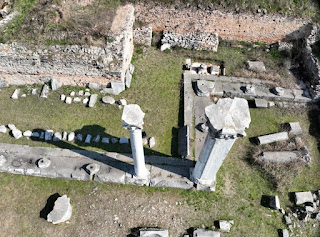The monumental complex of Basilica A at Philippi is being restored
Aerial View of the Archaeological Site of Philippi
Through the restoration of the monuments of the Basilica A complex — including the baptistery — the Ministry of Culture, via the Ephorate of Antiquities of Kavala, is proceeding with the restoration of the archaeological site of Philippi.
As part of its broader strategic plan for the protection of the archaeological site of Philippi and its Museum, the Ministry of Culture is also completing the fire protection and firefighting project, with a total budget of €2,500,000, funded by the Recovery and Resilience Facility.
The Baptistery of Basilica A, Philippi
Through the restoration of the monuments of the Basilica A complex — including the baptistery — the Ministry of Culture, via the Ephorate of Antiquities of Kavala, is advancing the restoration of the archaeological site of Philippi. As part of the functional enhancement of this major archaeological site, the second phase of its protection and promotion project is already underway, with a budget of €1,800,000, funded by the Regional Operational Programme of Eastern Macedonia and Thrace (NSRF 2021–2027).
Within the Ministry of Culture’s broader strategic planning for the protection of the archaeological site of Philippi and its Museum, the fire protection and firefighting project is also being completed, with a budget of €2,500,000, funded by the Recovery and Resilience Facility.
Aerial View of the Sanctuary Area of Basilica A
Minister of Culture Lina Mendoni stated:
“The archaeological site of Philippi, inscribed on the UNESCO World Heritage List, is a major archaeological site that includes particularly significant monuments.
Recently, the restoration of Basilica B was completed, including the reconstruction of parts of the superstructure and the stabilization of its ruins, with a budget of €754,000. The project was funded by the Regional Operational Programme of Eastern Macedonia and Thrace – NSRF 2014–2020.
We are now continuing with the restoration of Basilica A, along with a series of interventions aimed at the functional enhancement of the archaeological site and its fortification against fire, through the installation of a permanent fire suppression network. This is part of the National Plan for the Prevention and Management of the Impacts of the Climate Crisis on Cultural Heritage.
Basilica A is one of the most important monuments and points of interest within the archaeological site. It is the earliest and largest Christian episcopal church of Philippi.
Following the removal of the national road section that once passed through the archaeological site, the ancient Via Egnatia is now being unified with the road connecting the forum to the Early Christian Basilica A.
These interventions are creating a unified archaeological site, equipped with modern infrastructure for visitor access and safety, both for the public and for staff.”
Aerial View of Basilica A of Philippi
The Basilica A complex covers an area of approximately 6,800 square meters. Its construction dates to around 500 AD, and it appears to have been destroyed in the 7th–8th century. The building complex of Basilica A is situated at the continuation of a group of sanctuaries, mostly Roman, which are carved into the rock and, in part, into old quarries.
The Basilica A complex consists of the main church, the atrium, and the peristyle courtyard, accessed by monumental staircases, as well as the annexes, which include the baptistery with its vestibule and the chapel. The baptistery is a separate annex attached to the exterior of the north wall of the main church of Basilica A.
View of the North Wall at the Level of the Transept of Basilica A
The restoration project of the Basilica A complex focuses on the masonry and flooring in the main church, the narthex, and the eastern colonnade of the atrium. Some sections, such as masonry and architectural elements, are preserved in relatively good condition, while others — particularly decorative elements — exhibit severe damage, including material and form losses. Additionally, previous stabilization efforts are now deemed insufficient.
The current condition of the baptistery is considered relatively satisfactory, given several aggravating factors such as natural material deterioration, human intervention, and environmental influences, all of which have contributed significantly to the monument’s degradation.
The aims of the intervention are the conservation and protection of the monument complex, its unobstructed accessibility to the public, and its morphological and structural restoration — primarily at ground plan level — in order to enhance understanding of its original layout and geometry.
Section of the Stylobate of the Transept
The proposed interventions are based on the principles of respecting the natural terrain, utilizing the existing ground support structures, recovering lost sections, reusing ancient building materials, ensuring the distinguishability of new additions, and using modern materials for the morphological restoration of elements with an educational character.
Source







Σχόλια